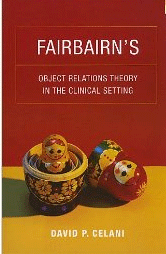Fairbairn’s Object Relations Theory in the Clinical Setting

“Fairbairn’s Object Relations Theory in the Clinical Setting”
By David P. Celani
Columbia University Press
New York, N.Y. 2010
Despite its complexity of ideas, book is rewarding
Reviewed by Paul Efthim, Ph.D.
If you’d like to strengthen your psychodynamic chops but aren’t ready to commit to years of analytic training, you might want to get a copy of this excellent book and immerse yourself in the model of W.R.D. Fairbairn.
Written by Vermont psychologist David Celani, “Fairbairn’s Object Relations Theory in the Clinical Setting” reviews the British analyst’s five seminal papers published between 1940 and 1958 and discusses their application in psychotherapy.
Celani has written extensively on Fairbairn, most recently in his 2005 book “Leaving Home: The Art of Separating from Your Difficult Family,” a splendid self-help guide for adults looking to free themselves from toxic family relationships.
Writing from an isolated perch in Scotland, Fairbairn offered a radical alternative to classical Freudian drive theory, which held that innate drives for pleasure-seeking are what motivate the child’s behavior. In Fairbairn’s view (which was influenced by clinical work with abused children), the child strives not for pleasure but for human contact and attachment.
Thus if a parent behaves in rejecting or unsatisfying ways, the child does not abandon the parent in search of more pleasurable experiences. Instead, because the child is absolutely dependent upon the parent, he or she dissociates the painful experience of parental failures in order to preserve the bond.
Fairbairn theorized that the child organizes relational events into three self-and-object pairs. The “central ego” is the conscious part of the mind that relates to the ideal object in the external world. The other two pairs, mostly unconscious, are the “libidinal ego” (which relates to the exciting parts of the object) and the “antilibidinal ego” (which relates to the rejecting object).
As Celani describes, the two dissociated self-and-object pairs mostly remain out of awareness but can emerge and suddenly take over the central ego. When this “splitting” defense is activated in treatment, the therapist can be misperceived as either an exciting or rejecting object.
Clinicians who work with borderline personality disorder will be intimately familiar with these sudden shifts in self-state. Celani shows how to draw on Fairbairn’s insights in order to help patients integrate material that has been split off and held in their unconscious sub egos where it wreaks havoc by fueling self-defeating patterns in relationships.
The book opens by placing Fairbairn in historical context and reviewing his early papers, then goes on to present his structural model in great detail. Fairbairn did not write very clearly and Celani does a yeoman’s job to make his ideas comprehensible. The author then applies the model to the therapeutic relationship and to specific populations, including borderline, obsessional and histrionic personality styles. Dozens of case examples help illustrate concrete suggestions for working with individuals who struggle with their “attachments to bad objects.”
This is a unique book that can be tough sledding at times due to the complexity of the ideas as well as the off-putting nature of some of Fairbairn’s terminology (e.g., “antilibidinal ego”). Some sections are repetitive and the book as a whole would benefit from additional copy editing. But these are nitpicks. The motivated reader’s patience will be handsomely rewarded.
Fairbairn was ahead of his time, anticipating today’s relational and attachment-based views of personality development. However, as Celani amply demonstrates, his greatest achievement was in creating a “complex and unique metapsychology that can be used every day in the consulting room as a ‘nuts and bolts’ model of psychopathology and psychotherapy.” This book is highly recommended to clinicians at intermediate and advanced levels.
Paul Efthim, Ph.D. is a licensed psychologist in private practice in Brookline, Mass. and holds a faculty appointment at the Boston Institute for Psychotherapy.
Learn more about the book: Fairbairn's Object Relations Theory in the Clinical Setting
